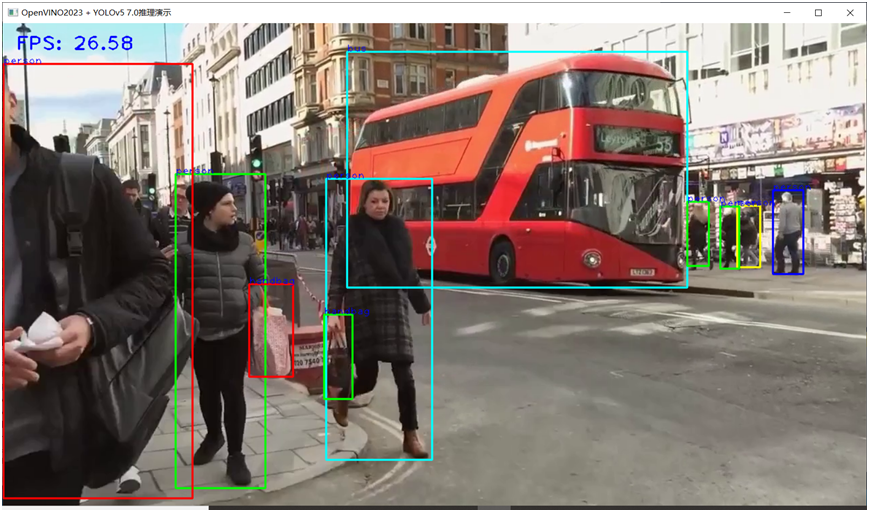OpenVINO2023异步回调流水线提升推理吞吐率
OpenVINO2023异步回调流水线提升推理吞吐率

OpenCV学堂
发布于 2023-11-21 16:30:00
发布于 2023-11-21 16:30:00
代码可运行
运行总次数:0
代码可运行
同步模式推理流程
OpenVINO2023版本的SDK支持同步与异步推理模式相比之前OpenVINO2021版本更加的简洁,易用。同时支持创建多个Requst然后基于多个Requst实现流水线方式的推理从而提升CPU推理的吞吐率。同步模式下OpenVINO2023 SDK的推理方式如下:

推理的流程如下:
while(true) {
// capture frame
// populate CURRENT InferRequest
// Infer CURRENT InferRequest
//this call is synchronous
// display CURRENT result
}以YOLOv5s的模型为例,在OpenVINO C++上同步推理的代码实现如下:
// 创建IE插件, 查询支持硬件设备
ov::Core core;
std::string model_onnx = "D:/python/yolov5-7.0/yolov5s.onnx";
auto model = core.read_model(model_onnx);
ov::CompiledModel cmodel = core.compile_model(model, "CPU");
// create infer request
auto request = cmodel.create_infer_request();
cv::Mat frame;
while (true) {
bool ret = cap.read(frame);
if (frame.empty()) {
break;
}
image_detect(frame, request);
char c = cv::waitKey(1);
if (c == 27) { // ESC
break;
}
}其中image_detect方法包含模型的图像前处理、同步推理、后处理。其中同步推理:
// 前处理
// 开启同步
request.infer();
// 后处理运行结果如下:

异步模式推理流程
当使用OpenVINO2023提供的Request对象的回调功能以后,我们可以把模型的后处理直接放到回调中去,这样异步推理方式就变成只有图像前处理+模型推两个步骤了,然后通过创建两个Request基于流水线方式,实现异步流水线模式推理方式,这个时候推理流程如下:

推理的流程如下:
while(true) {
// capture frame
// populate NEXT InferRequest
// start NEXT InferRequest
// this call is async and returns immediately
// wait for the CURRENT InferRequest
// display CURRENT result
// swap CURRENT and NEXT InferRequests
}首先需要创建两个Request,然后分别设置它们的Callback部分代码,主要是在Callback中完成后处理操作。这部分的代码如下:
// 创建IE插件, 查询支持硬件设备
ov::Core core;
std::string model_onnx = "D:/python/yolov5-7.0/yolov5s.onnx";
auto model = core.read_model(model_onnx);
ov::CompiledModel cmodel = core.compile_model(model, "AUTO");
// create infer request
auto request = cmodel.create_infer_request();
auto next_request = cmodel.create_infer_request();
std::exception_ptr exception_var;
request.set_callback([&](std::exception_ptr ex) {
if (ex) {
exception_var = ex;
return;
}
det_boxes.clear();
det_ids.clear();
ov::Tensor output = request.get_output_tensor();
const float* prob = (float*)output.data();
const ov::Shape outputDims = output.get_shape();
size_t numRows = outputDims[1];
size_t numCols = outputDims[2];
// 后处理, 1x25200x85
std::vector<cv::Rect> boxes;
std::vector<int> classIds;
std::vector<float> confidences;
cv::Mat det_output(numRows, numCols, CV_32F, (float*)prob);
for (int i = 0; i < det_output.rows; i++) {
float confidence = det_output.at<float>(i, 4);
if (confidence < 0.45) {
continue;
}
cv::Mat classes_scores = det_output.row(i).colRange(5, numCols);
cv::Point classIdPoint;
double score;
minMaxLoc(classes_scores, 0, &score, 0, &classIdPoint);
// 置信度 0~1之间
if (score > 0.25)
{
float cx = det_output.at<float>(i, 0);
float cy = det_output.at<float>(i, 1);
float ow = det_output.at<float>(i, 2);
float oh = det_output.at<float>(i, 3);
int x = static_cast<int>((cx - 0.5 * ow) * x_factor);
int y = static_cast<int>((cy - 0.5 * oh) * y_factor);
int width = static_cast<int>(ow * x_factor);
int height = static_cast<int>(oh * y_factor);
cv::Rect box;
box.x = x;
box.y = y;
box.width = width;
box.height = height;
boxes.push_back(box);
classIds.push_back(classIdPoint.x);
confidences.push_back(score);
}
}
// NMS
std::vector<int> indexes;
cv::dnn::NMSBoxes(boxes, confidences, 0.25, 0.45, indexes);
for (size_t i = 0; i < indexes.size(); i++) {
int index = indexes[i];
det_ids.emplace_back(classIds[index]);
det_boxes.emplace_back(boxes[index]);
}
});依据上述的推理流程,最终调用执行的代码如下:
cv::Mat frame, next_frame;
// do first frame
cap.read(frame);
async_image_detect(frame, request);
std::chrono::milliseconds tout{ 50 };
int cnt = 0;
while (true) {
bool ret = cap.read(next_frame);
if (next_frame.empty()) {
break;
}
int64 start = cv::getTickCount();
// 继续异步
if (cnt % 2 == 0) {
async_image_detect(next_frame, next_request);
request.wait_for(tout);
}
if (cnt % 2 == 1) {
async_image_detect(next_frame, request);
next_request.wait_for(tout);
}
for (size_t t = 0; t < det_boxes.size(); t++) {
int idx = det_ids[t];
cv::rectangle(frame, det_boxes[t], colors_table[idx % 6], 2, 8, 0);
putText(frame, classNames[idx].c_str(), det_boxes[t].tl(), cv::FONT_HERSHEY_PLAIN, 1.0, cv::Scalar(255, 0, 0), 1, 8);
}
// 计算FPS render it
float t = (cv::getTickCount() - start) / static_cast<float>(cv::getTickFrequency());
putText(frame, cv::format("FPS: %.2f", 1.0 / t), cv::Point(20, 40), cv::FONT_HERSHEY_PLAIN, 2.0, cv::Scalar(255, 0, 0), 2, 8);
cv::imshow("OpenVINO2023 - YOLOv5 7.0 异步推理", frame);
char c = cv::waitKey(1);
if (c == 27) { // ESC
break;
}
next_frame.copyTo(frame);
cnt++;
}
cv::waitKey(0);
cv::destroyAllWindows();
return 0;其中async_image_detect方法中实现了YOLOv5模型推理的图像前处理与启动异步推理模式
preprocess(frame)
// 开启异步
request.start_async();最终运行效果如下:

本文参与 腾讯云自媒体同步曝光计划,分享自微信公众号。
原始发表:2023-11-20,如有侵权请联系 cloudcommunity@tencent.com 删除
评论
登录后参与评论
推荐阅读

